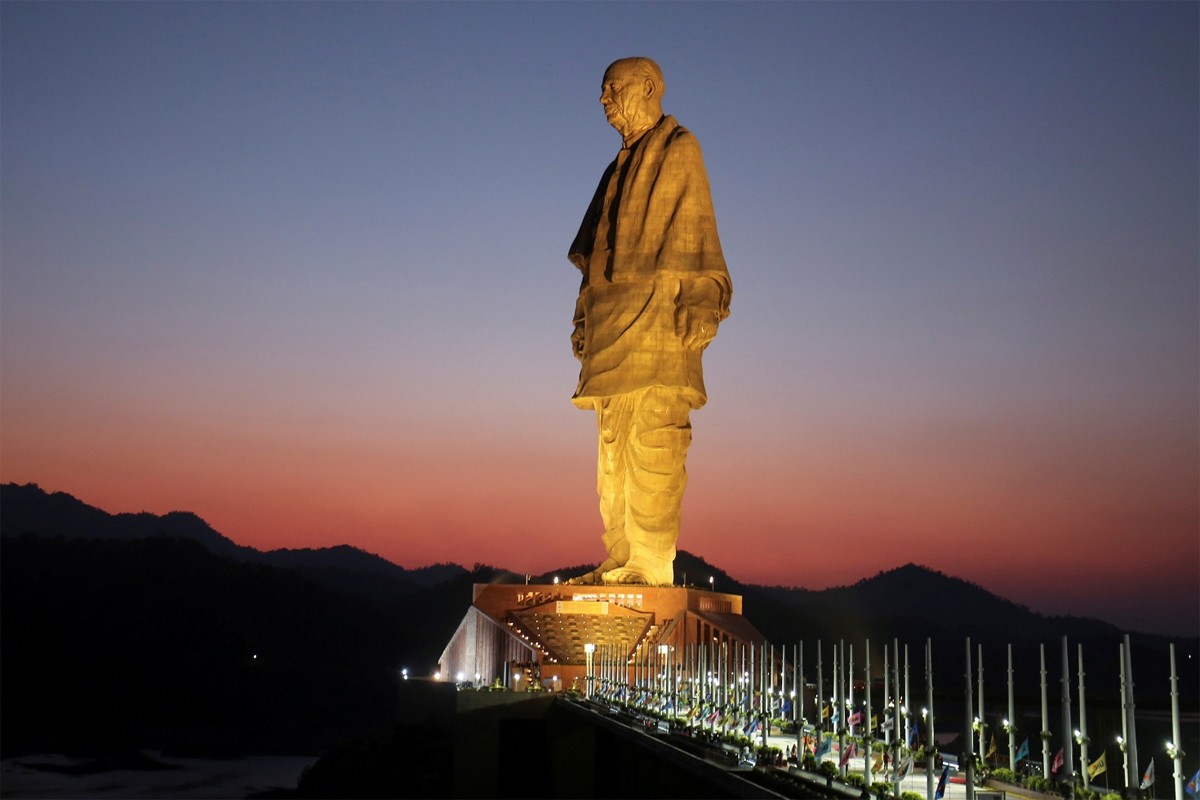Exploring the Statue of Unity: A Marvel of Engineering and Its Impact on India’s Economy
Discovering the World’s Tallest Statue – The Statue of Unity
Introduction to the Statue of Unity
The Statue of Unity, standing proudly at a staggering height of 182 meters (597 feet), is not just the world’s tallest statue but also a monumental tribute to Sardar Vallabhbhai Patel, one of India’s most respected leaders and the country’s first Deputy Prime Minister and Home Minister. Located in the state of Gujarat, near the Sardar Sarovar Dam on the Narmada River, this statue represents unity, strength, and resilience, symbolizing Patel’s role in unifying the diverse princely states into a single nation after India’s independence.
The Vision Behind the Statue of Unity
The vision for the Statue of Unity was born out of a desire to honor Sardar Patel’s legacy and to inspire future generations to understand the importance of national unity. Conceived by Indian Prime Minister Narendra Modi when he was the Chief Minister of Gujarat, the project aimed not only to commemorate a significant historical figure but also to boost tourism, create jobs, and promote regional development. The statue was designed by Indian sculptor Ram V. Sutar and constructed by the infrastructure giant Larsen & Toubro, completed in a record 33 months.

Architectural Marvel: Design and Construction
The Statue of Unity is an engineering marvel, both in terms of its scale and its sophisticated construction techniques. The statue’s height is twice that of the Statue of Liberty in the United States, making it an awe-inspiring sight. It is made of reinforced concrete clad in bronze panels, with the exterior designed to withstand wind speeds up to 180 km/h and earthquakes measuring up to 6.5 on the Richter scale. The statue’s structure is supported by two reinforced concrete cores connected by steel frames, ensuring its stability and longevity.
The statue stands on a three-tiered base, which houses a museum, an exhibition hall, and a viewing gallery at 153 meters, offering panoramic views of the Narmada River and the surrounding landscape. The construction involved the labor of over 3,000 workers and 250 engineers, showcasing the collaborative effort required to bring this colossal vision to life.
The Cultural and Economic Impact of the Statue of Unity
Boosting Tourism in Gujarat and Beyond
The Statue of Unity has quickly become one of India’s most popular tourist destinations, attracting millions of visitors from across the country and around the world. This influx of tourists has significantly boosted the local economy, particularly in the hospitality, transport, and retail sectors. The surrounding area, known as the ‘Statue of Unity Tent City,’ has been developed with various amenities, including luxury tents, resorts, and restaurants, catering to the diverse needs of tourists.
The statue has also spurred the development of related attractions, such as the Valley of Flowers, a butterfly garden, and an eco-friendly zone, further enhancing the tourist experience. The increased footfall has led to a surge in local employment opportunities, with thousands of jobs created in sectors like hospitality, tour guiding, and transportation. This development has been instrumental in elevating the standard of living for many locals and stimulating regional economic growth.

Economic Growth and Infrastructure Development
The impact of the Statue of Unity extends far beyond tourism. The project has been a catalyst for infrastructure development in the region, including the construction of new roads, bridges, and railways. These improvements have not only made the statue more accessible but have also facilitated trade and commerce in the region, contributing to the overall economic development of Gujarat.
The project has also attracted significant investment, both from the government and private sectors, in the form of hotels, resorts, and other tourist facilities. This influx of investment has further driven economic growth, creating a ripple effect that has benefited various industries, from construction to retail.
The Statue of Unity as a Symbol of National Pride and Unity
Sardar Patel’s Legacy and its Resonance Today
Sardar Vallabhbhai Patel, often referred to as the ‘Iron Man of India,’ played a pivotal role in shaping modern India. His efforts in integrating the 562 princely states into the Indian Union laid the foundation for the country’s current political structure. The Statue of Unity serves as a powerful reminder of Patel’s vision for a united India and his tireless work in achieving it.
The statue has also become a symbol of national pride, embodying the strength and resilience of the Indian people. It has reinforced the importance of unity in a diverse nation like India, where different cultures, languages, and religions coexist. The statue’s grandeur and the values it represents have made it a significant landmark not just in India but on the global stage, attracting attention from international tourists and dignitaries alike.
Educational and Inspirational Value
The Statue of Unity is not just a tourist attraction but also a place of learning and inspiration. The museum and exhibition hall located at the base of the statue provide valuable insights into Sardar Patel’s life, his contributions to India’s independence, and his role in the country’s unification. Educational programs and guided tours are available, offering visitors a deeper understanding of India’s history and the challenges faced during the post-independence period.
The statue also serves as an inspiration for future generations, encouraging them to embrace the values of unity, integrity, and dedication to the nation. The project has been particularly impactful in instilling a sense of pride and patriotism among the youth, who see in it a reflection of India’s progress and potential.
Environmental and Social Considerations
Sustainability and Eco-Friendly Initiatives
The construction and operation of the Statue of Unity have been accompanied by several eco-friendly initiatives aimed at minimizing the environmental impact of the project. The surrounding area has been developed as a green zone, with the Valley of Flowers and a butterfly garden serving as prime examples of the efforts to preserve the local ecosystem.
Renewable energy sources, such as solar and wind power, have been integrated into the statue’s infrastructure to reduce its carbon footprint. Additionally, the project has emphasized water conservation, with rainwater harvesting systems in place and efforts to maintain the ecological balance of the Narmada River.
Social Impact and Community Engagement
The Statue of Unity project has had a profound social impact, particularly in terms of community engagement and empowerment. The project has involved local communities at various stages, from the initial planning and construction phases to the ongoing operation and maintenance of the site. This involvement has not only provided employment opportunities but has also fostered a sense of ownership and pride among the locals.
Various social programs have been implemented in the region, focusing on education, healthcare, and skill development, further contributing to the upliftment of the local population. The project has also promoted cultural exchange, with visitors from different parts of India and the world interacting with the local communities, leading to a greater understanding and appreciation of diverse cultures.
The Future of the Statue of Unity and Its Role in India’s Growth
Potential for Further Development and Expansion
The success of the Statue of Unity has paved the way for further development and expansion in the region. There are plans to enhance the tourist experience by adding new attractions, such as adventure sports, cultural events, and festivals. These initiatives aim to increase the average duration of stay for visitors, thereby boosting the local economy even further.
The statue is also expected to play a key role in promoting Gujarat as a major tourist destination on the global stage, attracting more international tourists and investors. The continued development of infrastructure and amenities in the area will further solidify its position as a hub for tourism and economic activity.
Long-Term Economic Impact and National Significance
In the long term, the Statue of Unity is expected to have a lasting impact on India’s economy and its global image. The project has already generated significant revenue through tourism, and this trend is likely to continue as the statue gains more recognition worldwide. The economic benefits of the project are not limited to Gujarat but extend to the entire country, as increased tourism and investment contribute to national growth.
The statue also holds national significance as a symbol of India’s unity and progress. It serves as a reminder of the country’s rich history and the values that have guided its development. As a landmark, the Statue of Unity is a testament to India’s engineering capabilities and its ability to undertake and complete ambitious projects that have a positive impact on the nation and its people.

Conclusion: The Statue of Unity – A Monument for the Ages
The Statue of Unity is more than just a statue; it is a symbol of India’s unity, strength, and resilience. It stands as a testament to the vision of Sardar Vallabhbhai Patel and the progress that India has made as a nation. The statue has not only become a major tourist attraction but has also had a profound impact on the local and national economy, driving infrastructure development, creating jobs, and promoting regional growth.
As the world’s tallest statue, the Statue of Unity is a source of national pride and a landmark that represents India’s potential on the global stage. Its impact on the economy, culture, and society will be felt for generations to come, making it a monument for the ages.
